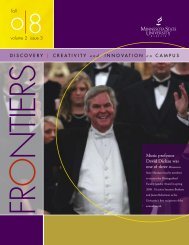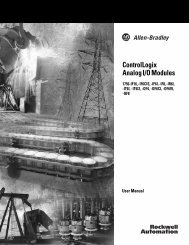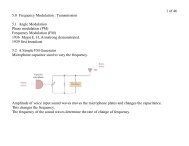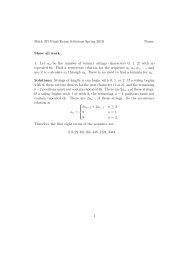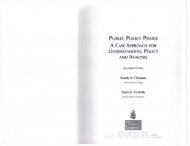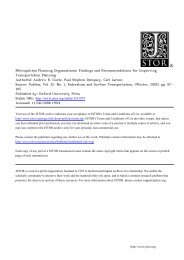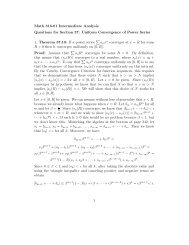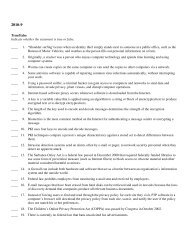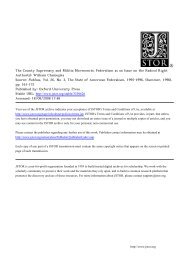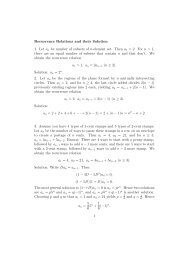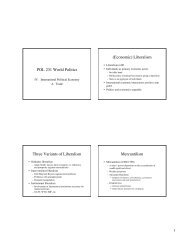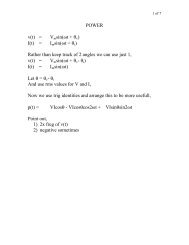Factor-Group Computations and Simple Groups - MavDISK
Factor-Group Computations and Simple Groups - MavDISK
Factor-Group Computations and Simple Groups - MavDISK
You also want an ePaper? Increase the reach of your titles
YUMPU automatically turns print PDFs into web optimized ePapers that Google loves.
Math 641 Abstract Algebra<br />
Questions for Section 15: <strong>Factor</strong>-<strong>Group</strong> <strong>Computations</strong> <strong>and</strong> <strong>Simple</strong><br />
<strong>Group</strong>s<br />
1. This is a needlessly long <strong>and</strong> complicated section. We will simplify it. The<br />
thing to concentrate on is Theorem 15.8 (page 147), Theorem 15.9 (page 147),<br />
Theorem 15.15 (page 149), Theorem 15.16 (page 149), Theorem 15.18 (page<br />
150). We will skip Theorem 15.20 (page 150) because it relies on Section 7,<br />
which we skipped. Let’s chase down the other theorems.<br />
2. Let H <strong>and</strong> K be groups. Then H × K/{(h, e) : h ∈ H} ∼ = H. Proof:<br />
Verify that φ : H ×K → H defined by φ(h, k) = h is a group homomorphism<br />
with kernel {(h, e) : h ∈ H}. So for example Zm × Zn/〈(1, 0)〉 ∼ = Zm.<br />
3. A factor group of a cyclic group is cycle. Proof: Let G be a group <strong>and</strong><br />
N a subgroup of G. Assume G = 〈a〉. Then G/N = 〈aN〉. For example,<br />
if G = Zn <strong>and</strong> N = 〈s〉 then G/N = 〈1 + 〈s〉〉. Verify this for n = 12 <strong>and</strong><br />
s = 3.<br />
4. A5 is a simple group, meaning that if N ≤ An is normal then N = {e}<br />
or N = An. The significance of this result is that it implies that there is no<br />
general formula for x in the quintic equation ax 5 +bx 4 +cx 3 +dx 2 +ex+f = 0<br />
by extracting roots (as there is, for example, for the equation ax 2 +bx+c = 0,<br />
where x = −b±√ b 2 −4ac<br />
2a ). Proof: Let N be a normal subgroup of A5, <strong>and</strong><br />
assume that N = {e}. We will prove that N = A5. Let σ ∈ N\{e} be<br />
given, <strong>and</strong> assume σ = c1c2 · · · ck is the factorization of σ into disjoint cycles<br />
of length ≥ 1 each (omitting 1-cycles for simplicity). Consider the following<br />
cases:<br />
Case 1. k = 1. Then we must have σ = (a, b, c) or σ = (a, b, c, d, e). In the latter<br />
case, (a, e, d, c, b) ∈ N <strong>and</strong> (b, d, c)(a, b, c, d, e)(b, c, d) = (a, d, b, c, e) ∈ N,<br />
therefore (a, e, d, c, b)(a, d, b, c, e) = (a, c, d) ∈ N. In either case, N contains<br />
a 3-cycle.<br />
Case 2. k = 2. Then we must have σ = (a, b)(c, d). Therefore (c, f, d)(a, b)(c, d)(c, d, f) =<br />
(a, b)(c, f) ∈ N, therefore (a, b)(c, d)(a, b)(c, f) = (c, f, d) ∈ N. Hence N<br />
contains a 3-cycle.<br />
So we know that in all cases N contains a 3-cycle. Call it (x, y, z). Then<br />
N also contains (x, z, y). So N contains every 3-cycle which involves the 3<br />
1
numbers x, y, <strong>and</strong> z. Now we will show that N contains every 3-cycle bar<br />
none. All we need to do is show that if N contains a 3-cycle then it contains<br />
another one with one number in the cycle replaced by another number not in<br />
the cycle. This is true: if (a, b, c) ∈ N <strong>and</strong> then (c, x)(a, b)(a, b, c)(a, b)(c, x) =<br />
(a, x, b) ∈ N.<br />
Now we will show that every product of two 2-cycles belongs to N. We<br />
have (a, b)(a, b) = e ∈ N, (a, b)(a, c) = (a, c, b) ∈ N, <strong>and</strong> (a, b)(c, d) =<br />
(a, b, c)(b, c, d) ∈ N.<br />
Now we will show that N = A5. We already have N ⊆ A5. Let σ ∈ A5.<br />
Then σ = τ1τ2 · · · τ2k for some choice of 2-cycles τ1, . . . , τ2k. But we have<br />
just proved that τ1τ2 ∈ N, τ3τ4 ∈ N, ..., τ2k−1τ2k ∈ N. Therefore σ ∈ N.<br />
Therefore A5 ⊆ N. Therefore N = A5.<br />
5. Let φ : G → G ′ be a group homomorphism. If N ≤ G is normal then<br />
φ(N) ≤ G ′ is normal. If N ′ ≤ G ′ is normal then φ −1 (N ′ ) ≤ G is normal.<br />
Proof: Exercises 35 <strong>and</strong> 36.<br />
6. Let N ≤ G be normal. We say that N is maximal normal in case there is<br />
no subgroup N ′ ≤ G such that N ⊆ N ′ <strong>and</strong> N ′ = N <strong>and</strong> N ′ = G. Theorem:<br />
N is maximal normal if <strong>and</strong> only if G/N is simple. Proof: Assume N is<br />
maximal normal. Let H ≤ G/N be normal. We must show that H = {eN}<br />
or H = G/N. Let X = {a ∈ G : aN ∈ H}. Then a simple argument shows<br />
that H is a normal subgroup of G <strong>and</strong> N ⊆ H. Therefore H = N (in which<br />
case X = {eN} or H = G (in which case X = G/N). Therefore G/N is<br />
simple. Conversely, assume G/N is simple. Let N ′ ≤ G be normal such<br />
that N ⊆ N ′ . Then a simple argument shows that Y = {aN : a ∈ N ′ } is a<br />
normal subgroup of G/N. Therefore Y = {eN}, which implies aN = eN for<br />
all a ∈ N ′ , which implies a ∈ N for all a ∈ N ′ , which implies N ′ ⊆ N, which<br />
implies N ′ = N, or Y = G/N, which implies for each g ∈ G there exists<br />
a ∈ N ′ such that gN = aN ⊆ N ′ , which implies g ∈ N ′ for all g ∈ G, which<br />
implies N ′ = G. Hence N is maximal normal.<br />
Homework for Section 14 (only the starred problems will be graded):<br />
Hints:<br />
5 ∗ , 25 ∗ , 27 ∗ , 35 ∗ , 36 ∗<br />
2
5. Compute all the left cosets. Then find an isomorphism between the coset<br />
group <strong>and</strong> Z4 × Z8. Alternatively, find a homomorphism φ : Z4 × Z4 × Z8 →<br />
Z4 ×Z8 which is onto <strong>and</strong> which has kernel 〈(1, 2, 4)〉 <strong>and</strong> use Theorem 14.11.<br />
25. U is the group of complex numbers z such that |z| = 1. The group<br />
operation is multiplication. Prove that the function φ : U → U defined by<br />
φ(z) = z 2 is an onto group homomorphism with kernel 〈−1〉 <strong>and</strong> use Theorem<br />
14.11.<br />
27. Prove that the function φ : R → U defined by φ(θ) = e 2πθi is an onto<br />
group homomorphism with kernel Z <strong>and</strong> use Theorem 14.11.<br />
3




